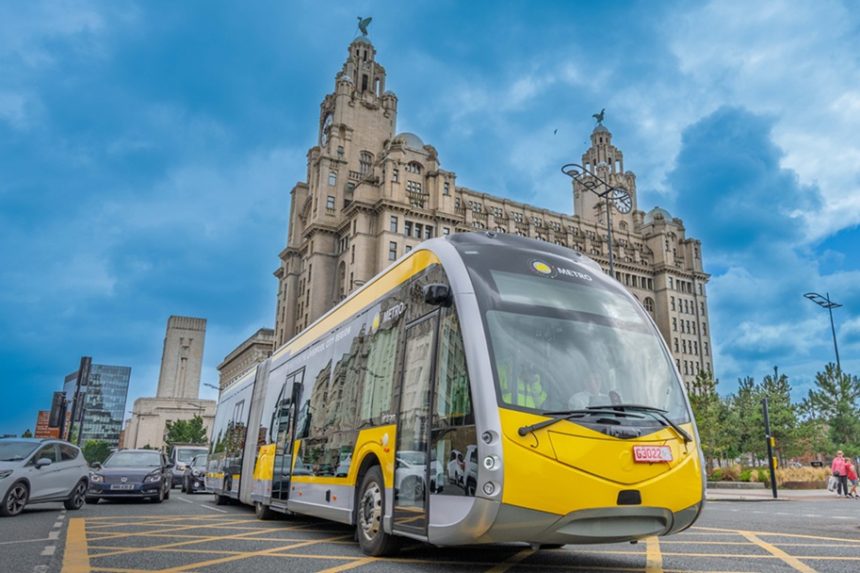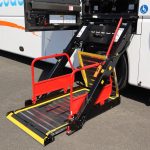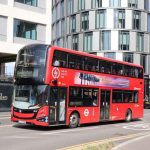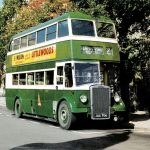Bus-based rapid transit will play a part in the integration of public transport in the Liverpool City Region, with work to assess potential vehicle types to deliver those services having continued with the visit of a left-hand drive Irizar ie tram battery-electric articulated bus in late July.
It is part of a batch destined for De Lijn in Belgium under a framework agreement with Irizar that was signed in 2024. Those vehicles will service showcase projects, such as bus rapid transit (BRT) in Kortrijk and Spartacus-branded routes in Limburg province.
In the latter case, an initial plan to operate Spartacus with trams changed to a bus-based approach. That echoes wider thinking by Mayor of the Liverpool City Region Steve Rotheram on how rapid transit will be deployed in his conurbation.
Soon before the ie tram demonstrator took to the road there, he used LinkedIn to note how a bus-centred solution can be delivered in the near future, “not 10 or 15 years down the line,” and that light rail comes with a high price tag, major regulatory challenge, a need for Westminster approval, and “years of disruption.”
In his manifesto ahead of the 2024 mayoral election, a commitment was given to establish BRT “similar to the Belfast Glider” that will connect the centre of Liverpool with John Lennon Airport and the city’s two football stadiums “by 2028.”
The concept is thus high on the priority list. Liverpool City Region Combined Authority (LCRCA) Executive Director, Place, Richard McGuckin says exploration of how that promise will fit into a jigsaw also involving franchised bus services and the Merseyrail network is at its early stages, and while a tram-esque appearance for the buses used is seen as important, those vehicles will be only one part of a wider product.

‘Wow factor’ among bus rapid transit priorities for Liverpool CR
BRT gives the opportunity to fill gaps in the existing public transport landscape in the Liverpool City Region, but if such a network expands beyond that pledged in the mayoral manifesto there is nothing to say that all of it will necessarily use articulated buses, comments LCRCA Rapid Transit and Bus Development Manager Tony McDonough.
“We want a ‘wow factor’, but those vehicles are available at different sizes,” he notes. Utilisation of 12m buses on future BRT is thus not ruled out; double-deckers are much less likely, however.
Richard suggests that some existing bus routes in the Liverpool City Region are better suited to a high-capacity BRT approach than conventional vehicles. Work is at an early stage, but trial of the ie tram follows an exercise in 2024 when a Van Hool Exqui.City diesel-electric hybrid was borrowed from Translink in Northern Ireland for assessment.
“We are motoring through development, and plans will become clearer over the coming months,” Richard continues. “Integration and connectivity are key to the Combined Authority, and we see BRT as part of the solution.”
Infrastructure is another important factor. Off-bus ticketing and multi-door boarding would need long, straight stopping areas, but he adds that consideration is still to be made on how road space would be given over to BRT.
Segregation while using existing provision is anticipated rather than wholesale building of new bus-only highways, with extensive priority expected as part of “a package of measures” to ensure that the ‘rapid’ aspect of promises is delivered.

Consistency with other modes needed, say officials
The Liverpool City Region has already ordered zero-emission double-deckers as part of its move to franchising. The first franchise contracts are expected to be awarded soon for mobilisation in 2026. When BRT starts, it could be that those services are first awarded on a standalone basis before transitioning into large franchising contracts later.
Precise vehicle specification will be consulted upon, as the Combined Authority did for new Merseyrail stock and for its earlier bus orders. Richard observes that a consistent internal finish across buses and trains is a priority. On why single-deck vehicles are favoured for BRT over double-deckers, capacity, stop dwells and personal safety are cited.
“We are looking at everything that will make it a rapid transit system,” says LCRCA Head of Network Development Lee Wasnidge. He has joined from Stagecoach and notes that while the city region already has an “enviable” public transport network, there is more to be done.
Stop frequency is a further item that needs close consideration for BRT, although Lee cautions that vehicle procurement is still some way away.
On other bus rapid transit corridors in the Liverpool City Region beyond the airport and football stadiums commitment, scant information is yet available. The Irizar ie tram was tested via tunnel beneath the Mersey into Wirral, where BRT has been put forward as an option for the extensive Wirral Waters redevelopment project.
With political momentum, longer-term visibility on city region transport funding in England and a good track record of patronage uplift on BRT schemes elsewhere, the future for it on Merseyside looks increasingly positive.

Interest in ie tram on the rise for manufacturer Irizar
Irizar is seeing UK interest in its ie tram product grow, and the De Lijn vehicle’s visit to the Liverpool City Region was accompanied by a strong delegation from the builder, including Group CEO Imanol Rego. Support during the bus’s stay was provided by local dealership Irizar UK.
The ie tram in 12m format has already been deployed here by Go-Ahead London on Transport for London route 358 and the Kent Thameside Fastrack network. Articulated examples are on order for Gatwick Airport; they will be 18.7m in length, but the example that visited Merseyside is the first built at 18.1m, the manufacturer advises.
Irizar UK Managing Director Andrew Blundell says that interest in the ie tram was driven by entry into service of the 358 batch in London, with those and the Fastrack examples having gained a high profile. European vehicle orders in hand for Irizar e-mobility are sizeable, with significant build capacity for 2026 already accounted for, he continues.
For the manufacturer, supply of the distinctive-looking vehicle is about supporting “step change” public transport projects rather than chasing volume orders, Andrew explains. The ie tram is built in Spain at an 18,000 square metre plant that uses 100% renewable energy and is close to, although entirely separate from, the Irizar coach factory.
While in the Liverpool City Region, the trial bus was supported by Stagecoach Merseyside, Cheshire and South Lancashire, which housed and charged it at Gillmoss depot. Irizar UK Business Development Manager, e-mobility, Andy Derz accompanied the vehicle throughout its evaluation.

Liverpool City Region Combined Authority Rapid Transit and Bus Development Manager Tony McDonough notes that the bus performed well during that testing. It was driven by an Irizar UK representative and attracted significant mainstream media attention during its brief stay.
It has 714kWh of battery capacity to give a claimed range of 300 miles. Drive is taken through the third axle using a central motor rated at 285kW. Overnight charging is thus utilised in this vehicle’s case, although opportunity replenishment is an alternative.
Andy notes that multiple battery chemistries are available to match the usage profile and charging requirement, which comes at slow, fast, and ultra-fast speeds. In the latter case, a maximum onboard battery capacity of 180kWh on the articulated variant is coupled to scope to accept power at up to 600kW.
The ie tram sits alongside the more conventionally styled ie bus, although that model is built only in left-hand drive format. Irizar has also made clear its interest in the zero-emission coach market, and in 2023 displayed a prototype of an i6S Efficient Hydrogen model. It uses fuel cell technology.


























